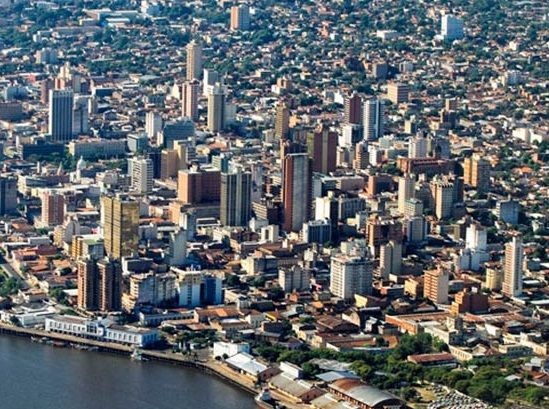
20 Mar 2023
The Case for Digital Infrastructure in Latin America's Paraguay
If I were to fly from my home airport of O'Hare International in Chicago to Asunción, Paraguay, my quickest journey would involve a couple of six-hour flights, with a stopover in Panama City, Panama. I would find a humid, landlocked country situated between Argentina and Brazil with an income level lower than that of Latin America's leaders, and four mid-sized data centers serving a smallish population of about 7 million people.
I would also land in a country with upside, according to data from the recent IDCA Smart Nations EESG Digital Readiness Index of Nations, a 147-nation review of economies, environments, social structures, and government functionality.
Paraguay's overall score in the EESG Index is fifth among the 23 nations surveyed in the region, trailing only Uruguay, Costa Rica, Chile, Brazil, and slightly ahead of Colombia. The data says Paraguay is worth investigating for its potential in developing new Digital Infrastructure and lifting the socioeconomic conditions of its people.
Why Paraguay Matters
Why does Paraguay merit this consideration? How does it rise above so many Latin American countries and site aside these other nations that are widely acknowledged as clear leaders in the region?
Renewable energy is the simple answer. Paraguay derives almost all of its electricity from hydropower, and exports some of it to its neighbors. The country as a whole emits a very small amount of CO2 and other GHG emissions. The second “E” in the IDCA Smart Nations analysis stands for environment, and when it comes to emissions Paraguay scores 76 on a 0-100 scale, comparable with Costa Rica and Uruguay. (The environment score in this index is heavily weighed toward emissions and emissions reduction, although other environmental factors such as water and disease are also factored.)
Paraguay's digital economy is far weaker than those of its peers, and it lags (sometimes badly) in the areas of internet access and speed and mobility. Its small data center footprint, though, is nonetheless comparable to Colombia when measured in terms of number of servers per million population. Its social structures and government function are also below average for the region, comparable to Guatemala and Honduras, and lower than any country on the South American continent other than Venezuela.
How Heavily Should GHG Be Weighted?
On the world stage, Paraguay's very strong environmental score places it in the world's Top 10 in that category, with the likes of Norway, Uruguay, and Costa Rica, and other surprising places such as Ethiopia, Kenya, and Uganda. Its very high environmental score vaults it within the top 50 among the 147 nations in its overall score, in the neighborhood of Brazil, Greece, and Taiwan.
Looking at these numbers can lead to a concern that the environmental score is weighted too heavily in this index. Surely, companies and investors cannot consider Paraguay (or for that matter, Ethiopia or Uganda) with the same seriousness as nations traditionally thought of as regional leaders, such as Brazil or Kenya, correct?
An analysis of the EESG Index is not meant to denigrate traditional leaders or to paint an unduly optimistic picture of Paraguay and other unexpected leaders.
Yet the world faces an existential crisis with respect to GHG reduction and climate-change abatement, according to climate scientists and their related academic apparatus, many UN initiatives, large governmental organizations including the EU, major investors such as BlackRock, and billions of individuals across the globe. The EESG Index emphasizes these concerns, and favorably scores countries that have installed substantial renewable energy.
What the Data Means and What It Doesn't Mean
The scores are not blind to historical and existing societal problems, although they do measure things on a per capita (per-person) basis, rather than with respect to population. Thus, the status and actions of Brazil with its 215 million people is far more consequential than those of Paraguay with its seven million.
The status and actions of China and India, with 35% of the world's population between them, can block out the sun in discussing any climate change in any other place. The US, still with 23% of the world's economy, will always exert massive influence in all climate-change conversations and the geopolitical power surrounding them.
The EESG Index data also tends to deliver higher environmental scores for nations with precious little physical or digital infrastructure – nations such as Ethiopia and Uganda cited above, the Democratic Republic of Congo, and Paraguay for that matter.
Yet Paraguay may be seen as a diamond in the rough, a small nation that has set itself up for future progress in that one key area – sustainable energy – that will ultimately drive all nations of the world as humanity races through the 21st century and its climate-driven fate.
A serious discussion of building more data centers and related digital infrastructure in Paraguay must account for existing local providers and their amenability to such discussions, the present state of the Paraguayan government, the complex regional politics that accompany all discussions everywhere, and numerous other local factors. So I haven't booked a ticket to Asunción just yet – but am willing to talk to anyone who'd like to visit this city with me.
Photo from Google Maps.
Follow us on social media:


.d57b427b.png&w=3840&q=75)

















